
Fort Funston spells f-u-n for enthusiasts
SAN FRANCISCO— Jake Brier furrows his brow and inhales audibly, working up the strength and the nerve to make his move. Finally, he’s ready.
He tightens his grip, runs full speed towards the cliff and takes off, soon joining the other flying specks in the horizon.
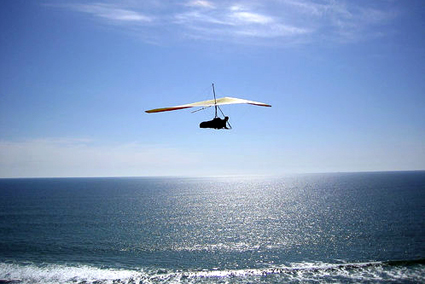 |
A hang glider is silhouetted by the midday sun at Fort Funston (Photo by Fatima Reynolds). |
Brier is one of the many hang gliders at Fort Funston. This rugged stretch of cliffs and coastline is an intermediate launching point, attracting seasoned pros from March to October when the winds are the most savage and therefore, the most fun.
“I think every kid growing up wished that they could fly. This is the closest you can get, short of growing your own wings,” said Rafael Lavin, clubhouse manager for the Fellow Feathers, a hang gliders’ club at Fort Funston.
| A pug makes his way up the road to Fort Funston (Photo by Fatima Reynolds). |
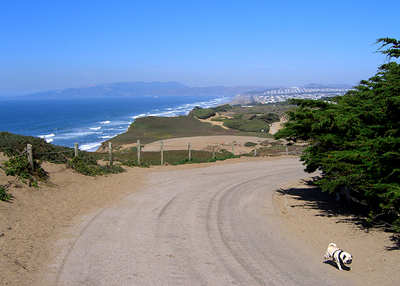 |
Indeed, the gliders slice through the western winds soaring high above the seagulls and pelicans. Nearby hang gliding shops offer instruction for the daring. Beginners are strapped in with a certified instructor and then advised to “run like hell and don’t touch anything,” said Lavin.
Brier reminisced about his first flight.
“It was exhilarating and pretty simple. I kept my hands to myself and enjoyed the view. Even landing was easy. I found it much less nerve-racking than when landing in a plane,” said Brier.
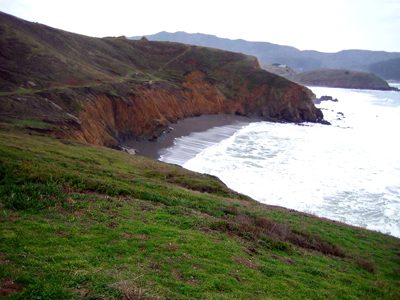
|
Rolling hills, jagged cliffs and foamy waves define the aura of Fort Funston (Photos by Fatima Reynolds). |
Brier said that Fort Funston is one of the best jumping off points in Northern California. Visitors can watch the gliders from a wooden platform that hugs the cliff.
The fort is located at the southern end of Golden Gate National Recreation Area; 230-acres of unspoiled shoreline. The 200-foot dunes, desolate beach and crashing waves make it a popular hang-out for man’s best friend and equestrians alike.
Fort Funston is a favorite destination for the active. The airborne and those that prefer both feet on the ground share the vivid backdrop and cool breezes. Dogs frolic through the native plants while bank sparrows make their homes in the towering dunes.
Sarah Roth comes a twice a week with Duke, her German Shepherd, to play and socialize.
| Three of Fort Funston’s patrons romping through the ocean (Photo by Fatima Reynolds). |
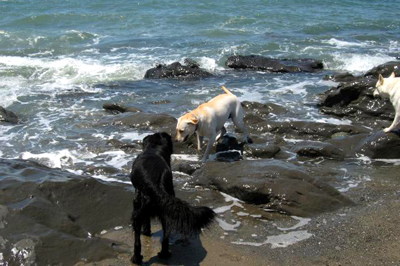 |
“We both love it here. It’s a little community of people and animals that come here to unwind, a sanctuary,” said Roth.
Migrating shorebirds seek refuge on the fort’s beach. Bank swallows, a threatened species, excavate and nest in the hillsides. A substantial colony forms beginning in April. Visitors have observed up to 150 nests scattered throughout the dunes.
The fort also attracts hikers with challenging trails through the shrubbery. The main trail called Sunset Trail, is paved and easy to follow. Other trails like the Sand Ladder Trail can be steep and unstable, because of loose sand and heavy erosion.
Hikers can observe the rich diversity of plant and animal life. Cottontail rabbits dart through the wild radish patches. Beach strawberries and miner’s lettuce sprout next to sea fig and daisies.
“It’s a vibrant palate. In the summer, the dunes are speckled with bright yellow flowers. What a sight to see,” said Eric Kozlik, an avid trekker. He and his wife Mari started coming to Fort Funston almost a decade ago.
“The winds are so wild. Every time we come, the terrain is different,” said Kozlik.
| A sign indicating the entrance to Fort Funston (Photo by Fatima Reynolds). |
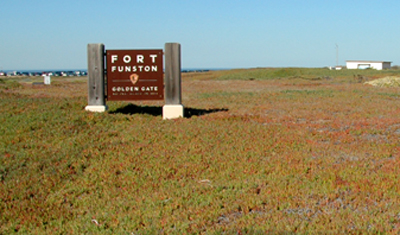 |
A native plant nursery lies behind the ranger station. Fort Funston is the San Francisco peninsula’s largest dune field. Volunteers work to protect the dunes, flora and fauna, planting seeds and remove invasive species, such as eucalyptus and cypress, brought in to conceal weaponry.
Fort Funston was once a military outpost with a two-gun battery that 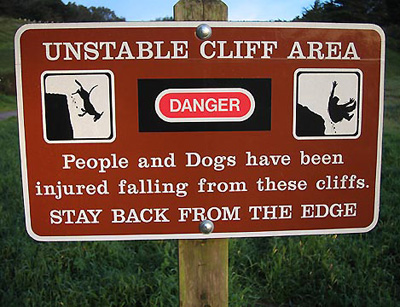 pointed seaward to protect the coast. Battery Davis was completed in 1938; the first casemated heavy caliber battery in the United States. The battery and the military barracks, transformed into an environmental education center, remain in tact.
pointed seaward to protect the coast. Battery Davis was completed in 1938; the first casemated heavy caliber battery in the United States. The battery and the military barracks, transformed into an environmental education center, remain in tact.
To view the battery, visitors can take the Sunset Trail at the northwest corner of the parking lot.
Park Ranger Matt Bellamy said Fort Funston is often ignored by tourists.
“Considering the volatility of the dunes and the myriad of people jumping off cliffs, I’d consider that more of a gift than a curse,” he explained.
If You Go
Contact Information:
- 500 Skyline Blvd., at John Muir Dr., San Francisco 94101.
- Phone: 415-561-4323.
Getting there:
- Take Highway 35 southbound, go past John Muir Drive and take the first right, there is a sign that indicates the entrance.
- Bear right and continue to the parking lot.
- Take Muni bus #18 to the park entrance at Skyline and John Muir Drive.
Fees:
- There are no entrance or parking fees.
Comfort:
- Dress warm for the intense winds and wear sturdy shoes, as the sand is loose and some trails require scrambling up and down the dunes.
| A dog explores the entrance to Battery Davis (Photo by Fatima Reynolds). |
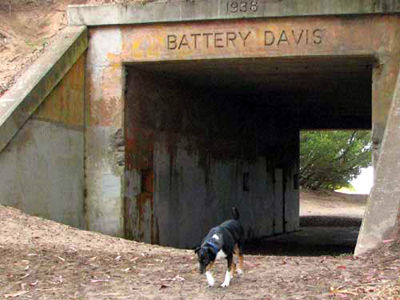 |

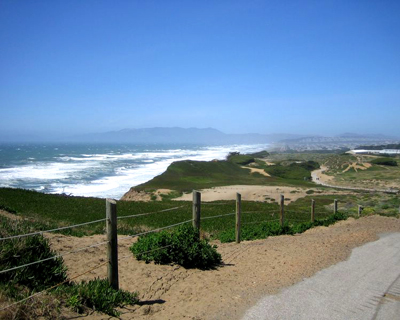
Comments are Closed